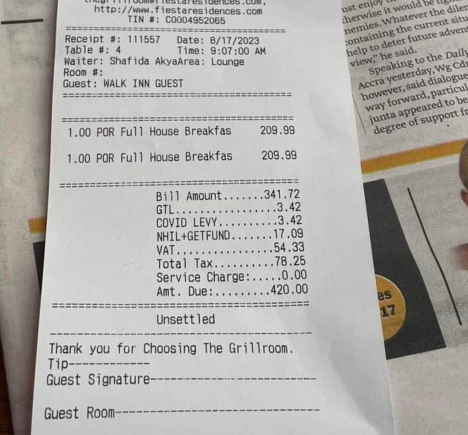
Ghana: Still calculating consumption tax incorrectly?
A consumption tax is a tax on the value of consumption just as an income tax is a tax on income.
Advertisement
So, if the value of consumption is GH¢100, you impose Covid levy (1% = 0.01), Getfund levy (2.5% = 0.025), NHIS levy (2.5% = 0.025), Tourism levy (1% = 0.01), and VAT (15% = 0.15) on GH¢100. You impose them separately on the value of consumption.
That is, in this example, the total consumption tax is 0.01*100 + 0.025*100 + 0.025*100 + 0.01*100 + 0.15*100 = (0.01 + 0.025 + 0.025 + 0.01 + 0.15)*100 = 0.22*100 = GH¢22 = 22% of GH¢100.
The sum of the levies (taxes) and VAT is 22%. So, you impose a total consumption tax of 22% on GH¢100 to get GH¢22 cedis.
Unfortunately, the Ghana Revenue Authority (GRA) has instructed businesses to compute the consumption tax differently.
In the example above, the sum of the levies is 7%. Under the GRA's method, this 7% is first applied to GH¢100 (the value of consumption) to get a consumption tax of GH¢7.
Then the GH¢7 is added to GH¢100 cedis to get a tax inclusive amount of GH¢107. Then the 15% VAT is imposed on the GH¢107 to get a consumption tax of 0.15*107 = GH¢16.05.
Thus, the total consumption tax is GH¢7 + GH¢16.05 = GH¢23.015.
The GRA's (and Ministry of Finance) incorrect calculation imposes a tax on a tax (i.e., the 15% VAT is imposed on the levy-inclusive value of consumption, which is GH¢107 in this example).
A levy is a tax!!! That is why levies require parliamentary approval. Even if parliamentary approval is not required, a levy is still a tax (with a different name).
The GRA's incorrect calculation increases the consumption tax rate from 22% to 23.05%. For large-value transactions and/or for transactions that involve millions of people, the 1.05 percentage point increase makes a big difference.
Look at the attached bill from Grillroom, a restaurant in Cantonments. The value of consumption (indicated as "bill amount") was 341.72 cedis.
Therefore, the total bill plus all the consumption taxes should have been 341.72 + 0.22*341.72 = 1.22*341.72 = 416.935 cedis.
But the bill (including consumption taxes) was 420 cedis which is equal to 341.72 + 0.2305*341.72 = 1.2305*341.72 cedis (this is actually equal to 420.48 cedis).
The VAT amount should have been 0.15*341.72 = 51.258 cedis. Instead, the VAT amount was 54.33 cedis. This was because the 15% VAT was imposed on the tax/levy-inclusive amount of 1.07*341.72 cedis to get 0.15*1.07*341.72, which is approximately equal to 54 cedis.
If the government wants to impose a consumption tax of 23.05%, why can't it do this in a transparent manner by asking parliament to increase one of the levies and/or VAT accordingly? Why does it use an incorrect and inconsistent method? Principles matter. Proper procedures matter.
In general, if L is the sum of levies and V is the VAT rate, the GRA's calculation increases the consumption tax by L*V (L times V). In the example above, V = 15% = 0.15 and L = 7% = 0.07. This gives L times V = 0.07 times 0.15 = 0.0105 = 1.05%, as obtained above.
Note: for some transactions (non-hospitality industry transactions), the 1% tourism is not applicable. This does not change the substantive point that consumption tax is incorrectly calculated in Ghana. It's a shame.
J. Atsu Amegashie
August 17, 2023
The writer is a Professor of Economics at the University of Guelph (Canada) and D&D Fellow, Center for Democratic Development (CDD), Ghana.



